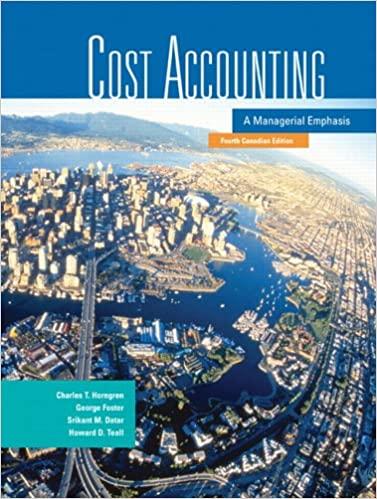Quality improvement, relevant costs, and relevant revenues. The Wellesley Corporation makes printed cloth in two operations, weaving
Question:
Quality improvement, relevant costs, and relevant revenues. The Wellesley Corporation makes printed cloth in two operations, weaving and printing. Direct mate¬
rials costs are Wellesley’s only variable costs. The demand for Wellesley’s cloth is very strong. Wellesley can sell whatever output quantities it produces at $1,500 per roll to a distributor who then markets, distributes, and provides customer service for the product.
Weaving Printing Monthly capacity 10,000 rolls Monthly production 9,500 rolls Direct material variable costs per roll of cloth processed at each operation $ 600 Fixed operating costs $3,420,000 Fixed operating costs per roll
($3,420,000 9,500; $513,000 - 8,550) $ 360 per roll 15,000 rolls
•;v 8,550 rolls
$ 120
$513,000
$ 60 per roll Monthly costs of quality information recorded by Wellesley are as follows:
Product and process design costs $ 360,000 8crap costs in Weaving Department 471,000
$crap costs in Printing Department 1,060,200 Wellesley can start only 10,000 rolls of cloth in the Weaving Department because of capacity constraints at the weaving machines. If the weaving operation produces defective cloth, the cloth must be scrapped and yields zero net revenue. Of the 10,000 rolls of cloth started at the weaving operation, 500 rolls (5%) are scrapped. $crap costs per roll, based on total (fixed and variable) manufacturing costs per roll incurred up to the end of the weaving operation, equal $942 per roll as follows:
Direct materials costs per roll (variable) $600 Fixed operating costs per roll
($3,420,000 4- 10,000 rolls) 342 Total manufacturing costs per roll in Weaving Department $942 The good rolls from the Weaving Department (called grey cloth) are sent to the Printing Department. Of the 9,500 good rolls started at the printing operation, 950 rolls
(10%) are scrapped and yield zero net revenue. Scrap costs based on total (fixed and variable)
manufacturing costs per unit incurred up to the end of the printing operation equal $1,116 per roll calculated as follows:
Total manufacturing costs per roll in Weaving Department $942 Printing Department manufacturing costs:
Direct materials costs per roll (variable) $120 Fixed operating costs per roll
($513,000 4 9,500 rolls) 54 Total manufacturing costs per roll in Printing Department 174 Total manufacturing costs per roll $1,116 772 The Wellesley Corporation’s total monthly sales of printed cloth equals the Printing Department’s output. The following requirements refer only to the preceding data; there is no connection between the situations.
Instructions Form groups of three students to complete the following requirements.
Required 1. The Printing Department is considering buying 5,000 rolls of grey cloth from an outside supplier at $1,080 per roll. 1 he Printing Department manager is concerned that the cost of purchasing the grey cloth is much higher than Wellesley’s cost ofmanufacturing the grey cloth.
The quality of the grey cloth acquired from outside is very similar to that manufactured inhouse. The Printing Department expects that 10% of the rolls obtained from the outside supplier will be scrapped. Should the Printing Department buy foe grey cloth from the outside CHAPTER 19 supplier?
2. How much does Wellesley lose if a defective roll is produced in the Printing Department?
3. What is the expected loss to Wellesley if a defective roll is produced in the Weaving Department? Use the expected monetary value criterion described in the appendix to Chapter 3.
4. Wellesley’s engineers have developed a method that would lower the Printing Department’s scrap rate to 6% at the printing operation. Implementing the new method would cost $420,000 per month. Should Wellesley implement the change?
5. The design engineering team has proposed a modification that would lower the Weaving Department’s scrap rate to 3%. The modification would cost the company $210,000 per month. Should Wellesley implement the change?
6. From your answers to requirements 1 to 5, what general conclusions can you draw about implementing TQM programs?
Step by Step Answer:

Cost Accounting A Managerial Emphasis
ISBN: 9780131971905
4th Canadian Edition
Authors: Charles T. Horngren, George Foster, Srikant M. Datar, Howard D. Teall




